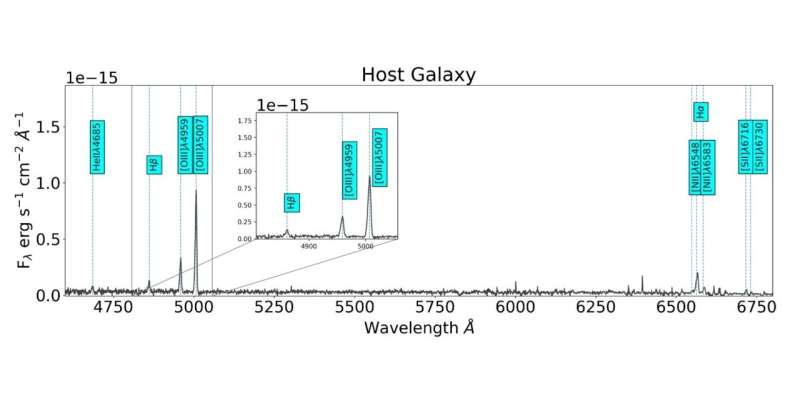June 6, 2024 report
This article has been reviewed according to Science X's editorial process and policies. Editors have highlighted the following attributes while ensuring the content's credibility:
fact-checked
preprint
trusted source
proofread
New rare 'green bean' galaxy discovered

Astronomers from New Mexico State University (NMSU) and elsewhere report the discovery of a new galaxy of a rare class, dubbed "green bean." The finding, made with the Karl G. Jansky Very Large Array (VLA), was presented in a research paper published May 29 on the preprint server arXiv.
The so-called "green beans" are very rare active galaxies glowing green under the intense radiation from the region around a central black hole. To date, only 17 such galaxies have been identified by the Sloan Digital Sky Survey (SDSS). Astronomers suppose that their rare occurrence is due to the fact that these sources may be experiencing a short-lived phase in their evolution.
Now a team of astronomers, led by NMSU's Kelly N. Sanderson, has detected another galaxy of this rare type. Using VLA, they have observed a source in the sky with extended radio emission, designated RGZ J123300.2+060325. Previous studies of this source, which is at a redshift of approximately 0.3, suggested that it may be a green bean galaxy.
"Here, we present a new green bean galaxy at z = 0.304458±0.000007 with large scale jet-induced radio emission," the researchers wrote in the paper.
The newly identified green bean galaxy received the designation RGB1. The observations show that RGB1 hosts an extended emission line region (EELR), which is most likely photoionized by an active galactic nucleus (AGN).
By analyzing the spectral age of the jet-induced extended radio emission in RGB1, the astronomers found that the duration of the jet production phase of the AGN is at least six million years. However, the collected data does not allow Sanderson's team to confirm whether the jet production phase is still ongoing.
The observations detected several detached clouds lying around RGB1, up to about 123,000 light years away from the nucleus. The ionization profile of these clouds suggests a decline in the AGN ionizing photon production over the past 150,000 years. Therefore, the researchers assume that RGB1 was in a phase of jet production prior to the radiatively efficient accretion phase traced by the currently observed EELR emission.
Summing up the results, the authors of the paper noted that the origin of RGB1 still remains uncertain and requires further multiwavelength observations in order to draw final conclusions.
"It is unclear whether RGB1 was a HERG [high excitation radio galaxy] that has transitioned into either a LERG [low excitation radio galaxy] or an inactive galaxy over the past ∼0.15 Myr, or whether the extended radio and optical emission trace distinct accretion phases that occurred in succession," the scientists concluded.
More information: Kelly N. Sanderson et al, Signatures of AGN feedback modes: A Green Bean Galaxy with 150 kpc jet-induced radio emission, arXiv (2024). DOI: 10.48550/arxiv.2405.19558
Journal information: arXiv
© 2024 Science X Network





















